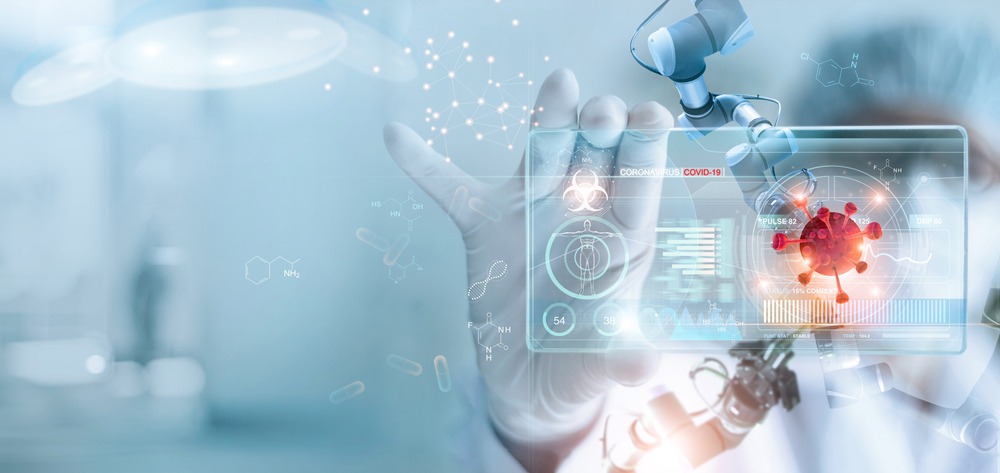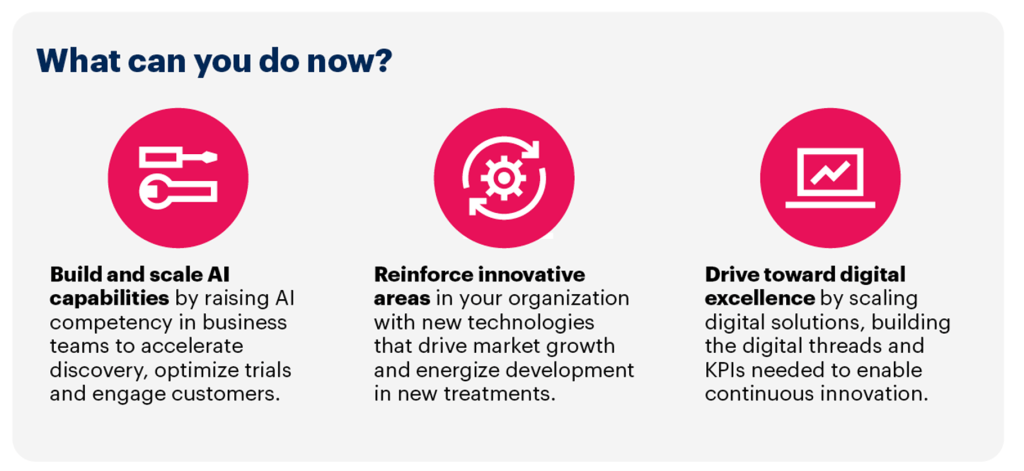
Laboratory Technology Trends to follow in 2024
The outlook for lab technology trends in 2024 promises to capitalize on the foundations of the Lab of the Future concept. While Digital Transformation has ushered in a new era of digitalization and optimized laboratory workflows, cloud computing has provided an affordable, scalable IT framework with access to an array of novel applications to support this vision further.
The widespread use of Artificial Intelligence (AI) has propelled digital capabilities, leading to unprecedented scientific advancement. AI-powered lab enterprises are transforming vast data landscapes into innovative insights, intelligent automation allows businesses to achieve their full digital potential, and mobile technologies enable seamless remote interaction and collaboration that keeps teams connected.
This blog explores these transformative trends, redefining how labs work in 2024 and setting the stage for future research and development powered by AI-driven workflows.
Low-code/No-code LIMS platforms
Low-code/no-code platforms offer many advantages to organizations by streamlining the creation of digital solutions, substantially reducing the time required to build and deploy applications.
Components can be easily assembled into applications by simply dragging and dropping, speeding up the development process and allowing for rapid adjustments in response to market trends or customer needs for LIMS platforms. Since less manual coding is needed, organizations can lower the costs associated with application development, enabling users with minimal coding ability to build and customize applications.
These platforms often come with integrated tools designed to support compliance with industry standards and best practices, reducing the security risks associated with application development. Organizations should evaluate these tools case-by-case to decide the best fit for their specific needs.
Mobile access to lab technology
Lab functionality is breaking free from the constraints of physical locations, transforming our traditional approach to work. Smartphones and tablets offer direct connectivity to Laboratory Information Management Systems (LIMS), allowing for remote operation and monitoring of lab instrumentation, on-site mobile data collection and analysis, and immediate updates to Electronic Lab Notebooks (ELNs) from any location.
The portability of lab technology provides the flexibility to perform essential lab functions remotely, like reviewing and approving reports from any location, gathering health data from patients in their homes, overseeing continuous cell culture growth without the need for after-hours visits to the lab, and ensuring safety by reducing exposure to potentially hazardous substances or biological agents.
Advancements in mobile technologies and the Internet of Things (IoT) deliver real-time insights for many lab activities previously only possible onsite. For example, these innovations enable the continuous monitoring of air and water quality to aid in environmental safety and conservation efforts. Integrated tools like cameras, GPS, and QR/barcode scanners are improving on-site testing and sample tracking to ensure accurate data collection and improve the overall data gathering and review process.
Collaboration in the remote workplace
In an increasingly remote work environment, collaboration has become essential and challenging for organizations worldwide. Despite geographical distances, working together efficiently is crucial for fast-paced scientific innovation. Collaborative efforts between industry and academia are particularly significant, as they foster the exchange of knowledge, expertise, and innovative ideas, which drive research and development and practical applications. Such collaborations help academia understand real-world industry issues while giving industries access to the latest scientific discoveries.
The rise of digitalization and process automation, particularly cloud-based LIMS (Laboratory Information Management Systems), has made data more findable, accessible, interoperable, and reusable (FAIR), meeting key prerequisites for advanced analysis with AI and ML. These technological advances facilitate the efficient storage, retrieval, and interpretation of shared data, enhancing the ability to derive insights and make informed decisions.
For collaboration to be effective in a remote setting, employing the right digital tools is essential. Cloud computing and AI enable seamless information sharing among global teams. As we move into 2024, these technologies, alongside platforms supporting digital engagement and tools like Generative AI, are vital for unlocking global knowledge and resources, thereby accelerating scientific progress.
AI and data-powered lab enterprises
AI and data technologies are transforming laboratory enterprises, driving data-led decisions, and offering real-time insights and visualizations. With advanced algorithms analyzing large data sets, these AI-enhanced labs enhance research efficiency and resource management.
AI-driven tools accelerate drug discovery processes, forecast molecular interactions, and identify potential drug candidates faster. These advancements also promote enhanced collaboration through improved data visualization, making complex data more accessible and sharable among researchers.
The convergence of AI with data technologies redefines scientific research and healthcare, leading to a new era of innovation and discovery.

- Build and scale AI capabilities by raising AI competence in business teams to accelerate discovery, optimize trials and engage customers.
- Reinforce innovation areas in your organization with new technologies that drive market growth and energize development in new treatments.
- Drive toward digital excellence by scaling digital solutions, building the digital threads and KPIs needed to enable continuous innovation.
Source: 2024 Gartner CIO and Technology Executive Survey1
Intelligent lab automation
Intelligent lab automation offers a future where lab equipment and processes are automated and made significantly smarter by AI, leading to a more efficient and innovative lab environment. This smart automation encompasses advanced robotics control, IoT features, and the ability to perform complex analyses.
Virtual assistants streamline training and operation, offering intuitive, voice-activated guidance for lab personnel. Standard lab procedures, along with the tracking of samples, can be efficiently automated through the use of smart robotics and application software. AI and ML-driven remote diagnostic tools and preventive maintenance protocols enable labs to take measures to reduce equipment downtime.
AI systems can adapt to new protocols and assays more easily than traditional automation. They can learn from new types of experiments and optimize the lab workflow. ML algorithms can be trained using role-based decision-making to recognize good results and to flag outliers or potential errors. This contributes to improved accuracy in quality control as unusual results can be automatically detected and reviewed.
With intelligent lab automation, data is not just collected; it is analyzed, sorted, and presented alongside recommended actions, offering unprecedented decision support and compliance. This shift paves the way for labs to run with optimized resource utilization and propels lab work into a future of innovation and streamlined efficiency.
Summary
By leveraging these trends and insights, organizations can adapt their strategies and operations to stay ahead in the rapidly evolving landscape of science and technology. Labs must update their digital infrastructure to support AI innovation, leading to smarter, more automated workflows that enhance lab efficiency. Ensuring the availability of high-quality data is vital for powering AI-driven analytics and fostering collaboration. Labs must move away from outdated LIMS and siloed data systems, investing instead in state-of-the-art LIMS that offer flexibility and are equipped with cutting-edge technologies. By embracing digital transformation and developing AI capabilities, labs will be positioned to drive continuous scientific progress and keep pace with the future of research and technology.
About Astrix
Astrix is the unrivaled market leader in creating & delivering innovative strategies, technology solutions, and people to the life science community. Through world-class people, process, and technology, Astrix works with clients to fundamentally improve business, scientific, and medical outcomes and the quality of life everywhere. Founded by scientists to solve the unique challenges of the life science community, Astrix offers a growing array of fully integrated services designed to deliver value to clients across their organizations. To learn the latest about how Astrix is transforming the way science-based businesses succeed today, visit www.astrixinc.com.
References:
1 Smith, J., “Infographic: 2024 Top Technology Investments and Objectives in Life Sciences”, Gartner, October 27, 2023.
Case Study: LabWare Centralized Data Review for a Global Biopharmaceutical Company
Overview A global biopharmaceutical company specializing in discovery, development,... LEARN MOREWhite Paper: Managing Data Integrity in FDA-Regulated labs.
New White Paper LEARN MORELET´S GET STARTED
Contact us today and let’s begin working on a solution for your most complex strategy, technology and staffing challenges.
CONTACT US


